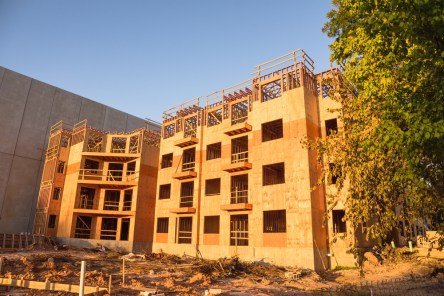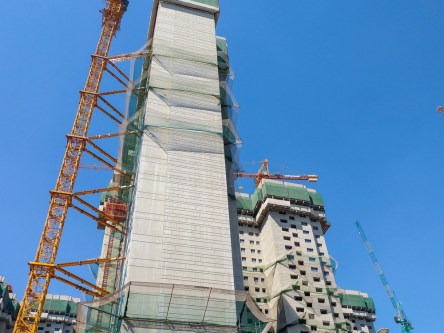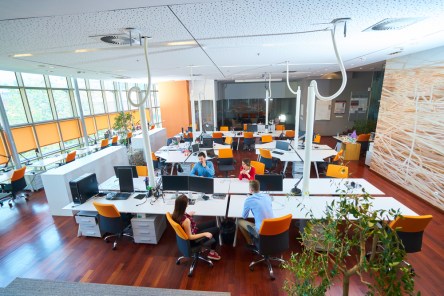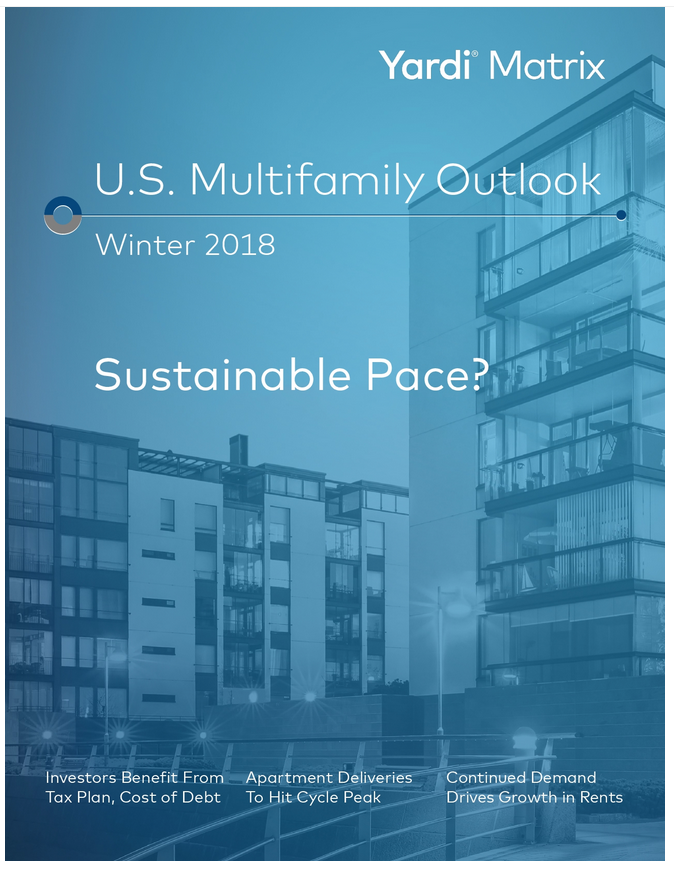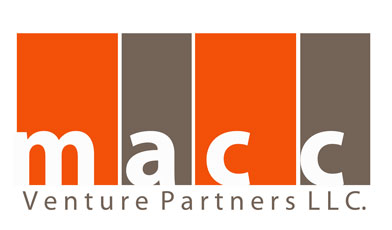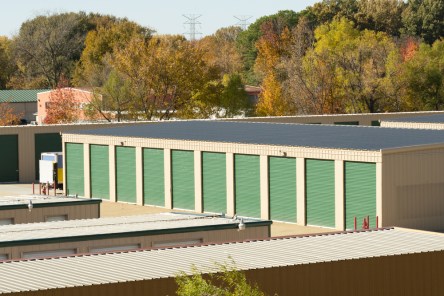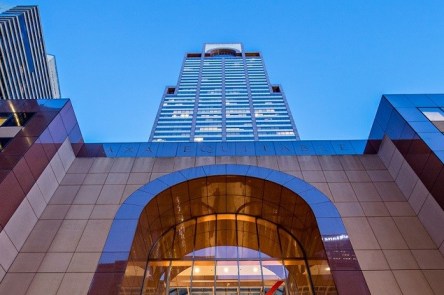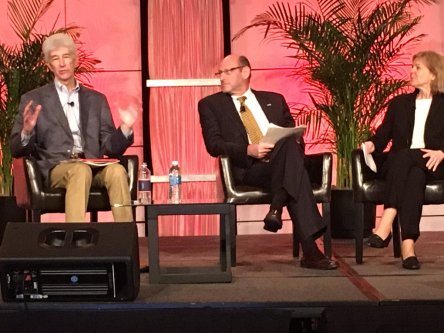Yardi Matrix took a close look at the U.S. industrial real estate market’s performance in the first half of 2018 and found plenty of positive signs. Indications of the sector’s strength include: Strong demand for space driven by year-over-year e-commerce sales growth of 15.4% Nearly 125 million square feet of industrial space coming online 7% year-over-year rent growth A national vacancy rate below 5% in the first quarter, the lowest since 2010 Commercial real estate-leading investment volume “Demand is stronger than ever” in every industrial subsector, the report says, with warehousing, manufacturing and flex space accounting for most of the occupancy gains. Demand was strongest in California’s Inland Empire, followed by Chicago and New Jersey. The industrial sector continued to benefit from rising e-commerce sales, which totaled $120.4 billion in the second quarter alone and drove the need for distribution centers near dense population areas. Over 90% of the first half’s new supply was warehouse and distribution space, with more than 238 million square feet of additional space under construction at mid-year. In markets where available land for development is scarce, developers focused on renovation and site remediation projects, expecting to recover costs with higher rents. Industrial rents continued to increase in most markets, spurred by the exceptional demand and lack of excess space in the top logistics markets. Rents averaged $6.29 per square foot at mid-year, up 7% year-over-year. “Expect rents to further increase through 2018 as the quality of available inventory improves due to upgrades and addition of new space,” the report says, noting that a slight deceleration might follow in 2019 as projects now under construction add to available inventory. The national industrial vacancy rate, 4.9% in the first quarter, was largely due to companies snapping up space before it was...
Multifamily Update
From Yardi Matrix
Jeff Adler, vice president of Yardi Matrix, assisted by Jack Kern, director of research and publications, recently delivered a webinar on the state of the multifamily industry. Excerpts follow. Q: How is the U.S. economy overall? A: It’s in good shape. Gross domestic product and employment are steady, wages are rising and the labor market is tight. Inflation is rising but under control. Q: And the multifamily market? A: It’s good too, although there are a few crosswinds. Jobs and population growth are strong but shifting to lower-cost cities, and homeownership is gradually rising. Multifamily capital is abundant, and new supply deliveries are weighing down on several markets, with the level of new supply flattening but not declining. Q: Has multifamily supply leveled out, and why? A: Construction delays and financing are a factor. Construction is just catching up to household formation, and builders are focusing on higher-price single family homes. Q: What are some policy changes addressing affordability? A: There are some proposed and implemented government mandates. Other market-oriented changes include a community in Kissimmee, Fla., that encourages residents to cover some of their rent by sharing their apartment on Airbnb; “rent by bedroom” communities that combine private bedrooms with shared kitchen and living areas. The coworking trend offers a model for coliving. Societal infrastructure, especially education, is the power of local economy, which drives multifamily investment. Q: What job growth trends are affecting multifamily? A: Companies are relocating and expanding in lower-cost markets—places like Phoenix, Orlando, Fla., Houston, Las Vegas and Raleigh, N.C. Tech hubs are emerging both in formerly non-tech metros and traditionally overlooked cities, such as Indianapolis, Pittsburgh and Philadelphia. Q: What are some of the other factors in play? A: The 2017 tax reform that caps the deduction for...
Self Storage Update
From Yardi Matrix
The self storage industry has been strong over the last several years, with economic growth creating new households and driving demand. Can this pace continue or will the recent supply surge outpace demand? That question formed the basis of a recent web presentation by Jeff Adler and David Dent, vice president and senior real estate market analyst, respectively, for Yardi Matrix. Their discussion focused on four areas: Macroeconomic Outlook The U.S. economy is in very good shape, Adler and Dent reported, with gross domestic product growing, inflation under control, and a tight labor market “pulling people off the sidelines,” although trade and immigration policies could brake the growth. Their research reveals that millennials and Baby Boomers are leaving big cities such as New York, Los Angeles, Chicago and Miami in favor of smaller, lower-cost cities with concentrations of intellectual capital work, which in turn drives storage demand. Destination metros include Dallas-Fort Worth, Tampa, Fla., Atlanta and Charlotte, N.C., along with retirement favorites such as Las Vegas and smaller mountain metros in the Appalachians and the Rockies. However, rental market fundamentals are faltering, with only 12 of 133 markets studied by Yardi Matrix showing year-over-year rent increases in September 2018, versus as many as 41 in previous years. Profile of Current Supply and Demand Domestic migration patterns have made Las Vegas, Tampa, Phoenix, Orlando. Fla., and Columbus, Ohio, the most attractive metros for self storage providers, Adler and Dent reported. The national average of self storage projects under construction and planned as a percent of existing inventory is 9.5%. Portland, Ore., Nashville, Tenn., Orlando, Boston and Seattle have the highest percentages. Approximately half of storage customers are in the process of moving while the other half are long-term users. Adler and Dent noted that approximately...
Office Update
From Yardi Matrix
A strong U.S. economy has given rise to an equally robust office real estate market. Office-using employment and wage gains outpace the national average growth rate, according to a recent report from Jeff Adler and Jack Kern, vice president and director of research, respectively, for Yardi Matrix. Their update, presented in a webinar, focused on the macroeconomic outlook, national office fundamentals and trends, and technology disruptors. Employment, gross domestic product, household formation and income levels are in good shape, supporting growth in the office market segment. More than half of the 115 major markets surveyed by Yardi Matrix are experiencing moderate rent growth. Intellectual capital—companies and workers—are leaving high-cost gateway markets such as New York, San Francisco and Los Angeles for lower living and business costs. Job growth is highest in emerging tech hub markets such as Reno, Nev., Boise, Idaho, Nashville, Tenn., and Orlando, Fla. An aging population is fueling growth in the medical office sector, especially in Sun Belt locations. “Most markets remain undersupplied because supply isn’t keeping up with demand,” Adler said. High levels of pre-leasing activities indicates continued strong demand and likely swift absorption of new supply, especially in tech hub market hubs such as Austin, Texas, Raleigh-Durham, N.C., and Orlando. Other pressures on the office market include a decreasing amount of square footage per employee, which is especially pronounced in central business districts and high-cost metros. In addition, coworking is growing, especially in dense, high-cost gateway markets, diverting 1-3% of office demand from traditional office leases. Coworking could eventually represent 10% of available space, Adler said, with Yardi a leader in providing the infrastructure and technology for coworking and shared space environments. Technology trends likely to change the nature of work and create wealth in office real estate include...
Risky Business
Are Your Properties Protected?
A recent Yardi Matrix research bulletin titled “Flood and Fire: The Multifamily Sector’s Response to Natural Disasters,” assesses the state of U.S. multifamily markets in areas hit hard by natural disasters in 2017 including hurricanes and wildfires. Hurricanes alone caused around $110 billion in total reported property damage. The bulletin also covers the impact of these events on the insurance market, and advises that property owners in the private insurance market should be ready for increasing rates and deductibles along with tightening policy terms and conditions. It’s Hurricane Season Again As cited in an April 2018 Multifamily Executive article, the U.S. was hit with 16 severe weather events in 2017. And now that this year’s hurricane season is underway, property owners and managers should ensure that their communities are as safe and sound as possible to prevent against future losses should a major storm hit. One key tip: install critical infrastructure above flood-prone areas. Recommended actions outlined in the article include relocating electrical panels, mechanical equipment, meters and shut-offs to higher ground. Sealing cracks in walls and foundations and installing sump pumps will go a long way to shoring up a property. Using materials that are designed to survive water exposure and resist mold for framing, wallboards, floorboards and ceilings is also a great plan. Mitigating Property Risk When it comes to safeguarding properties, being ready for extreme weather isn’t the only consideration for property owners. To protect against resident-caused damages, a required renters insurance program is a widely accepted industry best practice. For property owners without renters insurance at their communities, now is a great time to consider implementing a program to mitigate risk. A program that includes fast and easy signups for residents and automated compliance monitoring for property managers is ideal....
Demand Information
Matrix Multifamily Report
A new report by Yardi Matrix indicates that multifamily deliveries might outpace demand in some key U.S. housing markets. Matrix conducted a study to determine which areas might be at risk of oversupply or undersupply over the next five years. The research revealed that deliveries in 2016 and 2017 helped compensate for the construction shortage in the wake of the Great Recession. “Most of the metros that are at short-term risk of oversupply have strong economies and healthy multifamily demand, so units coming online should be absorbed by growing populations,” the report concludes. Markets and submarkets with outsize development activity, however, “can expect volatility” that will give rise to higher vacancy rates and stagnant rent growth. Achieving market equilibrium going forward will require developers to “intelligently calibrate the amount and location of new projects” to accommodate finite demand. Yardi Matrix identified Denver, Seattle, Dallas, Phoenix, Miami and Charlotte, N.C., as key markets at risk of oversupply over the next five years. Demand is projected to exceed supply of apartments for rent in San Diego, Los Angeles, California’s Inland Empire, Houston, New York and Sacramento, Calif. Read “U.S. Multifamily Supply and Demand Forecasts by Metro” to learn more about homeownership, population shifts, social trends and other factors affecting the multifamily...
Multifamily Update
From Yardi Matrix
What’s the verdict on the U.S. multifamily market—healthy, ailing or somewhere in between? Data presented in a recent webinar led by Yardi Matrix indicates that the news is mostly good. “Despite a fair number of headwinds that include decelerating rent gains, growing supply, the advanced age of the economic cycle and the increase in interest rates, the multifamily market remains in a healthy state,” says a presentation delivered by Jeff Adler and Jack Kern, vice president and director of institutional research, respectively, for Yardi Matrix. Positive signs for the U.S. multifamily market include: The economy, which grew by 2.3% in 2017 and the first quarter of 2018, added more than 200,000 jobs so far in 2018 and spurred a high level of consumer confidence; Plateauing rental unit deliveries combined with steady economics that will increase rents by an estimated 2.9% in 2018; Rising wages and a tight job market that “pulls people off the sidelines”; Moderate inflation Potential crosswinds include: Demand—meaning jobs and population—which, while strong, is shifting to lower-cost cities, driving a gradual rise in homeownership; Increasing financing costs; Abundant multifamily capital, holding cap rates steady and compressing spreads; New supply deliveries that are still being absorbed in many markets. There’s lots more insight in the full webinar. The recording, presentation and accompanying report are available...
Super Service
Valet Living Leverages Matrix
Actionable information on which multifamily markets offer the best prospects of penetration has fueled Valet Living’s rapid growth. For three years, Valet Living has used Yardi Matrix, a business development and asset management tool for underwriting and managing real estate investments, to identify the number of Class A, Class B and garden-style properties in a market, unit mixes and the construction pipeline. Thanks in part to Yardi Matrix, Valet Living now serves 1 million apartment homes in 38 U.S. states. Valet Living’s services include trash collection, recycling, turns (preparing units for new residents), pet care and maintenance. The company will soon announce additional resident-facing amenities. “Yardi Matrix data, from the individual property level all the way to overall industry market conditions, drives our sales,” said Bruce Tokarski, senior financial analyst for Valet Living. “Apartment community attributes generate a scorecard that identifies the most promising communities to penetrate. This creates leads for our sales team. Before Yardi Matrix, we just walked up to a property and hoped for the best.” He added, “Yardi Matrix research also helps our operations team. We can estimate the volume of trash generated per unit mix and therefore how much money and resources we need to budget for a community. In addition, new construction reports help us understand a market’s pipeline. All these reports are customized to our needs and make our lives easier.” Valet Living of Tampa, Fla., has been setting the standard for doorstep collection and recycling since 1995. Servicing more than 1 million apartment homes in 38 states, Valet Living is the only national provider of doorstep collection and recycling services and the only nationally recognized full service amenities provider to the multifamily industry. In addition to doorstep collection, Valet Living’s turns, maintenance and pet station solutions...
Informed Investments
With Fogelman Properties
In 14 years as a Yardi client, Fogelman Properties has adopted a variety of solutions that comprise a single connected platform for running its real estate property and investment management business. For example, automating resident insurance enrollment at its rental properties produced 100% insurance compliance. Another solution for tracking and managing leads gave rise to more cost-effective marketing and improved employee training. Fogelman also automated its property management, accounting, resident screening and online payment processing operations. More recently, Fogelman sought to bring new clarity to its property management and real estate investment strategies. That decision prompted the company’s adoption of Yardi Matrix. Yardi Matrix compiles market and property-level research for underwriting real estate loans and investments. “We will use Yardi Matrix data about supply, demand, sales, loans, leases and other factors to identify markets we might consider investing in,” said Mark Fogelman, president of Fogelman Properties. “It will also provide data on comparable properties to help us benchmark the performance of properties we currently own against the competition. Yardi Matrix will be a major contributor to profitable investments and informed property management.” “We are proud to deliver the full capabilities of Yardi Matrix and excited to participate in another chapter of Fogelman’s 55-year history as one of the property management industry’s top companies,” said Jeff Adler, vice president of Yardi Matrix. Fogelman, founded in 1963 and based in Memphis, Tenn., is one of the largest and most experienced privately-owned multifamily investment and property management companies in the U.S. It specializes in multifamily acquisitions, property management, construction management and asset management. Fogelman presently operates 80 multifamily communities totaling 28,000 apartment homes in 10 states. Schedule a demo to learn more about how Yardi Matrix helps leading real estate investors make better decisions on property prospecting, underwriting and asset...
Disaster Recovery
Matrix Report on Multifamily
A new research bulletin from Yardi Matrix assesses the ongoing recovery of multifamily markets in U.S. areas hit hard by hurricanes, wildfires and other natural disasters in 2017. Three hurricanes inflicted about $110 billion in property damage and $300 billion of economic loss in Texas, Florida and Puerto Rico, the bulletin notes, with the affected counties in the two states accounting for about 13% of total U.S. housing permits. Relocation by renters and homeowners sparked a rapid rise in apartment rents. Houston, for example, saw a 1.6% increase over the last four months of 2017, reversing about 18 months of decline. While increases were lower in Miami, Tampa and Orlando, this may change as residents displaced from Puerto Rico, which still needs major infrastructure resources, spur demand in these Florida metros. The bulletin predicts that the long-term need for housing will lead to higher occupancy rates, especially in the renter-by-necessity segment. Another factor impacting the housing recovery is a shortage of construction labor, driven by fewer young people entering the industry and a declining immigrant labor force. “As a result, expect prolonged construction delays nationwide,” the bulletin says. The report also examines natural disasters’ impact on the insurance market. Property owners in the private insurance market “should brace themselves for not only increasing insurance rates but also tightening terms and conditions of their policies,” the bulletin says, noting that “insurers are increasing deductibles for multifamily portfolios, and changing the deductible structure from a dollar value to a percentage of property value.” In California, which endured wildfires from San Diego to Sonoma, Proposition 103, an insurance regulatory measure, is expected to moderate rate hikes. Download the complete bulletin, titled “Flood and Fire: The Multifamily Sector’s Response to Natural Disasters.”...
Coworking Trends
Yardi Matrix Insight
Yardi Matrix has completed the first report that quantifies the amount of office space dedicated to coworking in office buildings with 50,000 square feet or more in 20 large U.S. markets. “Coworking represents a small yet growing segment of the office market,” the report says, noting that that 20 markets contain more than 1,100 coworking space encompassing almost 27 million square feet of space. This total represents 1.2% of the total office space in those markets. Shared workspace originated in the 1990s to provide space for self-employed workers and employees traveling or working remotely. The practice expanded after the Great Recession, driven by a growing gig economy, cost-cutting strategies and other factors. Today, the report says, “coworking represents a small yet growing segment of the office market” that helps companies accommodate remote employees, attract talent, promote work satisfaction and reduce leasing costs. Eleven of the 20 metros in the Yardi Matrix study have more than 1 million square feet of coworking space for lease, led by Manhattan, N.Y., with 7.65 million square feet in 245 spaces and the Los Angeles office space market with 3.7 million square feet of coworking space in 158 locations. Nine other metros have at least 1 million square feet dedicated to coworking. Miami has the most coworking space as a percentage of total stock, at 2.7%. “Demand is high in markets with concentrations of knowledge workers—especially IT but also new media or industries such as biotechnology and telecommunications—that are friendly to startups [and] in metros where space is at a premium,” the report says, and lower in metros such as Dallas and Houston that have low barriers to construction and high vacancy rates. The practice is more prevalent in urban settings due to the concentration of workers there and...
Looking Up
Multifamily Market Predictions
What does a largely stagnant year for the multifamily industry in 2017 imply for this year? How will economic, tax policy, demographic, capital market and supply factors impact the segment? These and other issues comprise the content of “Sustainable Pace?”, a new market analysis compiled by Yardi Matrix. The Yardi Matrix research team’s study suggests that there’s enough steam left in the sector’s bull run to make multifamily a solid, dependable real estate market segment over the next 18 to 24 months for property owners, residents and investors. Rent growth cooled in 2017 amid robust development and occupancy levels began to trend down in some metros. On the upside, demand for multifamily shows no signs of slowing in 2018, as the renter cohort ages 20-34 keep growing while retirees continue to downsize. Urbanization and other social trends will also conspire to keep rental demand steady. Economy: Bright Prospects With regard to the national economy, “we expect another year of moderate economic growth, which potential upside from the recently passed tax reform bill that will lower tax rates and encourage corporate investment,” the report says, adding, “Job growth could slow as the labor market nears full employment, but should remain healthy.” A 17-year high in consumer confidence plus healthy housing, automobile, manufacturing and other segments are additional positive indicators. Rent Growth: Modest but Steady Following multifamily’s significant deceleration in 2017, the report forecasts rent growth in the 2.5% range nationally this year, with increases in supply and lack of affordability in high-cost metros checking growth. “Supply is the biggest headwind,” the report says, forecasting apartment deliveries in 2018 to increase by 20% to 360,000. This new supply will outstrip demand and prompt a slow slide in the occupancy rate. Sacramento, Calif., is the projected leader...
Growing with Matrix
MACC Venture Partners
With 4,200 units of owned multifamily housing, MACC Venture Partners is on a mission to more than double in size, according to managing partners Tony and John Azar. Based in Gastonia, N.C., MACC Venture Partners is a private equity owner operator of commercial real estate engaged in active pursuit of capital preservation and appreciation. With over 4,200 owned apartment units and over 5,000 under management, the family owned and operated firm is currently pursuing an aggressive growth strategy of Class B and C properties in the Southeast U.S. To identify the best deals to augment its portfolio, MACC Venture Partners chose Yardi Matrix as its source of dependable real estate data. Matrix offered the most complete information for the most reasonable price point, and covered all the markets required, John Azar said. Yardi Matrix is the real estate data provider of choice for MACC Venture Partners because of its comprehensive market analytics, including for secondary and tertiary real estate markets. Many of the properties that MACC Venture Partners considers for acquisition are often located outside of major cities, so coverage of these markets is important for the company. “The granularity of the data was important to us and not only from a primary market perspective. We don’t operate just in major metro areas, we operate in first, second and third tier areas. Yardi Matrix has the data we need,” said Azar. Matrix was instrumental during MACC Venture Partners’ recent acquisition in North Myrtle Beach, South Carolina, where the company purchased a 168-unit garden apartment community in partnership with Legacy Capital Partners. “(Matrix) was very relevant to this transaction because North Myrtle Beach area had less available data than Myrtle Beach. This was a situation where Yardi gave us good data not just about the...
Multifamily Outlook
Smooth and Steady
Yardi Matrix reports another strong summer for the multifamily real estate sector. The fundamentals were downgraded from “great” to “consistently good” but several factors suggest continued, healthy performance. Even rapid development in some of the nation’s hottest markets has slowed to a more sustainable pace due to construction labor shortages. The shortages may have longer-lasting effects due to disaster recovery efforts throughout the United States. Rents For the last year-and-a-half, rent growth as gently declined as rents inched upward. The rent growth deceleration may be drawing to an end, though, as the supply boom reaches it apex. National average rents increased by 2.4% on a year-over-year basis in August, yet are down from 4.6% at this time last year. Deliveries are not manifesting as quickly as previously anticipated, which should moderate rent increases. The long-term outlook for multifamily seems promising due to favorable fundamentals and demographic trends: Millennials are forming households, wage growth remains solid, and the economy is relatively healthy. Hottest Markets The hottest metros for rent growth are still secondary markets that are lagging on supply. Tacoma (8.1 percent), Sacramento (7.7 percent), Colorado Springs (7.6 percent) and the Inland Empire (4.3 percent) are four of the fastest growing markets yet they’re only estimated to increase stock by 1 percent this year. These markets benefit from their proximity to larger markets such as Seattle, the Bay Area, Denver and Southern California. They enjoy vigorous employment growth and popularity with Millennials. The young renters look forward to the areas’ desirable lifestyles with lower costs. There are always exceptions. Seattle faced 5.9 percent rent growth regardless of the surge in supply. Analysts are exploring the connection between rents and the city’s increased minimum wage. Minimum wage increased from $9.47 in 2015 to $13. Nashville is...
Apartment Trends
RENTCAFE Construction Report
We’d need 4.6 million new apartments by 2030 to meet demand for rental living and keep prices in check, reports the National Multifamily Housing Council. That’s about 373K new units each year on average, a number that’s rather optimistic considering the pace of apartment construction in the last decade. So how feasible is this plan? A recent study from RentCafe on the apartment market suggests the country’s growing renter population need not be too concerned. According to data from real estate data provider Yardi Matrix, apartment construction is at a 20-year high, with most of our country’s biggest cities seeing significant upgrades in rental stock. After a slow post-recession period, the market started rebounding in 2012 and by 2014 new supply had amounted to more than 237,000 units delivered in one year, well above historical averages. Between 1997 and 2006, annual completions averaged 212,740 units. In 2017, apartment completions are expected to top 345,000, a 21% increase compared to last year’s deliveries when more than 285,000 units saw the light of day. Hot Urban Markets See Rents Softening as Developers Ramp Up Apartment Construction After peaking in 2014 at 5.1%, monthly rent prices rose just 1.5% to $1,316 in May, the lowest annual growth rate we’ve seen in more than three years. In 2017, the average U.S. rent is expected to increase a modest 3.9%. Does this mean apartment prices are finally taking a break from rent growth? Apparently so, and thanks to intensified apartment construction, that’s even the case with some of the country’s historically tight (or rather outrageously expensive) markets. Close to 6,200 new units entered the San Francisco metro area in 2016, with approx. 5,400 apartments expected to be delivered this year and another 9,500 under construction. While demand is still strong...
Buzz Sessions
Thought Leadership Events
Have you heard the buzz? Yardi is hosting a new series of free thought leadership events for small to mid-size property managers across the US. These Property Management Buzz Sessions bring together industry experts and local professionals for networking, educational sessions and conversation about local market conditions. The most recent Property Management Buzz Session just popped up earlier this month! Twenty-eight representatives from sixteen companies met with the Yardi team at the InterContinental Los Angeles in Century City. The event lasted from 9 a.m. until just after noon, starting with a networking breakfast to energize the group for the full agenda ahead. 5 Keys to Property Management Success The first presentation of the Buzz Session took attendees through a high-level overview of changing trends in today’s marketplace. It included discussions about mobility, Millennials and modern renter expectations. Did you know that 85% of renters prefer to apply online? What does that mean for businesses that want to stay competitive? Heather Burleson talked through winning strategies for busy multifamily and commercial property managers. Metro LA Market Trends & Report Next David Dent from the Yardi Matrix team took the floor to share a closer look at local market trends in LA. Data shows that apartment rents are still rising steadily in the area and new units projected for completion will add the most growth to downtown, Westlake and Koreatown. Commercial real estate conditions indicate that LA office inventory is also growing, and the group reviewed vacancies, rental prices and new supply. Attendees each received a complimentary market report to take back with them to share with their offices. David remained available after the session, and guests took advantage of the opportunity to ask questions one on one. Ensuring Software Success In addition to Yardi staff...
Self Storage Data
Yardi Matrix Expands
Yardi Matrix has expanded its self storage coverage to 125 markets, up from 99. This total represents 26,535 properties, of which 1,398 are some form of new supply, and 1.4 billion square feet of space and encompasses 83% of the U.S. population. The addition of 26 markets produces the self sector’s most comprehensive market intelligence and competitive analysis source. Yardi Matrix also covers multifamily and office portfolios. “Matrix is now the largest data set for market intelligence and competitive analysis in the self storage sector. The recent expansion is the latest example of Yardi’s commitment to providing the industry’s leading tools for identifying and executing development, management and underwriting deals,” said Jeff Adler, vice president of Yardi Matrix. Yardi Matrix is a business development and asset management tool for investment professionals, equity investors, lenders, and property managers who underwrite and manage investments in commercial real estate. Its resources include true ownership, in-place debt, and rental and sales history data, along with a new supply pipeline that includes 1,398 tracked projects. Yardi Matrix covers multifamily, industrial and office property types in addition to self storage. Email [email protected], call 480-663-1149 or visit yardimatrix.com to learn...
CRE Tech Trends
Teel Talks at Realcomm
Rob Teel, senior vice president of global solutions for Yardi, offered perspective on new tools that help commercial real estate companies gather, analyze and use data in new ways in an interview at the Realcomm conference in San Diego. Guided by collaboration with clients and industry trends, Yardi is directing its product development beyond traditional accounting and back office systems. “Most transactions, such as purchase orders by employees and work orders by tenants, start in the field and usually on a mobile platform. We want to continue pushing ERP upstream to the source of transactions, and capture data that goes to the general ledger from the first transaction,” Teel explained. He cited COMMERCIALCafé Tenant, a downloadable app that extends online services to mobile devices, as an example of this effort. VENDORCafé, which automates manual processing involved in validating and onboarding vendors, also offers secure, mobile access to the ERP. Teel also mentioned the investments Yardi has made, through acquisitions and development, to develop a comprehensive energy offering that includes intelligent HVAC optimization, submeter-level usage analysis and fault detection. With these capabilities in hand, Yardi now focuses on putting them together as “a holistic offering that helps clients reduce their energy spend and promote sustainability,” he said. He also discussed Yardi Matrix in terms of the artificial intelligence and guided analytics trends that were popular topics of discussion at Realcomm. For years Yardi Matrix has been gathering information on commercial, multifamily and self storage facilities across the U.S. The challenge now, Teel said, is to “use that repository of information about leases, rental rates and other characteristics to help clients make smart decisions about pricing properties, forecasting budgets and reporting to analysts and stakeholders,” Teel said. Extending Yardi Matrix beyond data capture and leveraging the...
Top Office Deals
2016 Transaction Recap
The U.S. commercial real estate market took something of a respite in 2016, during a year characterized by political volatility. Compared to the previous year, when the market fired on all cylinders, office players were more cautious in 2016, with leasing and sales activity cooling down to more sustainable levels, per most industry reports. Office tenants were reluctant to make any major moves pending the conclusion of the presidential election, thus lease renewals and consolidations took the stage in the past year. Though office sales activity also decreased 7% year-over-year, according to Colliers, the national transaction volume was still the fourth-highest yearly total in the past 15 years, reaching $140.5 billion. We enlisted the help of Yardi Matrix sales data to round up a list of the 50 largest office deals of 2016. The results of our analysis aren’t all that surprising: the New York City office investment market remains the most attractive destination for both local and offshore buyers, though other markets also landed a good deal of capital in the past year. The U.S. office market is poised to become even more attractive in the future, especially to foreign investors, if Brexit goes through. Check out the list of the top 50 largest office deals of 2016 on the CommercialCafe blog. NYC Home to Largest Single-Asset Sale of the Year The priciest office transaction in New York City and the second-largest overall office deal of the year was the $1.93 billion sale of the AXA Equitable Center at 787 Seventh Avenue in Manhattan. One of the biggest investments in pension fund CalPERS’ history, the sale closed Jan. 27, 2016, at $1,179 per square foot. The 51-story, 1.6 million-square-foot tower is LEED certified and includes 49,000 square feet of retail space, a parking garage and access to the underground concourse of Rockefeller Center. CalPERS bought the...
Manhattan
A Renters’ Market?
For the first time in four years, average rents in Manhattan are decreasing across the board. In the past, rents occasionally declined in one or two floor plans. Larger units demonstrated the most notable price fluctuations. Highly sought-after studio units were most likely to maintain consistent or climbing value. Yet according to a recent Bloomberg report, the current decrease in prices applies to apartments of all sizes. An increase in supply is the main catalyst. Recent construction has given Manhattan renters more options. The Eugene, the tallest residential skyscraper in the city, began leasing this year. Vitrea and Waterline Square, both with jaw-dropping architecture, are also enticing renters their way. Throughout Manhattan, more than 20 new buildings will start leasing this year, according to Curbed. The new competition has created an atmosphere that hasn’t existed since 2012: excess apartments sitting vacant on the market for weeks. The conditions encouraged many landlords to explore less expensive asking rents—for Manhattan, anyway. Bloomberg reports that median rents for studio apartments dropped by 2.6 percent. In February, that translated to a median list price of $2,500. Prices for one-bedroom units fell by 1.3 percent to $3,350. Two-bedroom apartments declined the most, dropping 5.2 percent to $4,500. With a decrease of 3.7 percent, three-bedroom units have the second farthest decline. These units average $6,031. The median rent price for all units decreased 0.9 percent to $3,350. Landlords have dropped asking prices by an average of 3.3 percent, 0.8 percent lower than February 2016, report appraiser Miller Samuel Inc. and brokerage Douglas Elliman Real Estate. The report highlights 6,872 vacant units at the close of February. That’s 12 percent more vacancies year-over-year. Melinda Sicari, a broker with Douglas Elliman, recalls the change in customer bravado, “In the months of January...
NMHC Panel
Economic Outlook from Matrix
Before the presidential election, the consensus economic forecast was more of the same slow-growth environment that has prevailed since the Great Recession ended. However, the election of Donald Trump changed expectations for domestic output, prompting interest rates to rise. Yardi Matrix vice president Jeff Adler and CBRE Americas head of research Jeanette Rice spoke to these changes and more during the Apartment Markets: The Macro Perspective panel at the National Multifamily Housing Council’s recent Apartment Strategies Outlook Conference. The panelists discussed what rising interest rates could mean for an interest-rate sensitive asset class such as commercial real estate. Adler asserted that the impact will be determined by how much and how fast rates increase and property performance. A prolonged period of rising rates could diminish property valuations, but at the same time a modest decline in values caused by a one-time bump in rates could be offset with revenue increases. Although it will take some time before the true impacts can be fully gauged, if interest rates are an indication, then economic productivity and inflation could rise in the coming years. The panelists deliberated upon what happens to cap rates as interest rates and (by extension) property values move higher. Adler believes that Cap rates are likely to moderately rise and valuations may take a slight hit as interest rates increase, however the key factors will be the pace of rate increases and the concurrent revenue growth. He shared a model that Yardi Matrix® created to predict the impact of both interest rate and revenue increases and determined that mild and steady interest rate increases can be significantly offset by healthy revenue growth, and as a result valuations should remain stable. Looking at an internal rate of return (IRR) calculation, an increase in interest...
Multifamily Outlook
Yardi Matrix Looks At 2017
The multifamily market has seen phenomenal growth in rents and property values for several years. Can the good times continue to roll in 2017? We think they can, though the rate of rent increases is going to slow down, transaction yields have likely bottomed and oversupply is going to negatively impact some markets. However, we expect that the multifamily market will continue to enjoy positive fundamentals. The biggest factor is that demand for multifamily is poised to remain robust for years, maybe as much as a decade. The number of Millennials between the prime renter ages of 20 and 34 is projected to increase by two million before it peaks at almost 70 million in 2024. That coincides with a bump in the number of white, college-educated renters relocating to urban areas for the “18-hour” city lifestyle that includes entertainment and access to public transportation. As the young worker pool grows, unemployment rates have dipped below 5 percent and wage growth has intensified, hitting 2.8 percent year-over-year as of October 2016. The result is a boom in household formations, which have steadily risen since slumping badly in the wake of the last recession. A further reason for optimism is that new supply has not kept up with the surge in multifamily households. The number of renter households increased by 9.3 million in the 10 years between 2005 and 2015, according to the Census Bureau, while the number of owner-occupied households dropped by 2.1 million. The result is that occupancies of stabilized properties are near all-time highs, at 95.8 percent nationally as of October, according to Yardi Matrix. Even though supply has rebounded from the recessionary lows—Yardi Matrix forecasts about 350,000 units to come online in the U.S. in 2017—that is barely enough to match...
John Azar
MACC Venture Partners
For Yardi Matrix client John Azar, one of the most important aspects of any real estate transaction is rigorous due diligence. That means having the most comprehensive, up-to-date market information available to make a smart buying or selling decision. In 2016, Azar’s firm MACC Venture Partners began using Yardi Matrix for apartment market data, switching from their previous data source, one of the industry’s best known providers. “We kept looking at the disparity in cost and at the data being produced, and we really couldn’t find enough difference to justify the large cost difference between Yardi and our previous vendor,” Azar explained. “The integrity of the Yardi data is just as good and in some cases better, and Yardi offered much more competitive pricing. And Yardi is very responsive. Client services are always on point.” Ten-year-old MACC Venture Partners, which is closing in on almost 5,000 apartment units in the Southeast United States, has also made customer service a vital part of its success. The family-owned private equity firm is currently branching out into fund management – its first ever $25-$30 million fund will launch this month. “It is our first fund, a closed-end private equity fund. We are growing and making more products available to our investors. But we’re still a family owned company, so they are going to get the same service they would get from most real estate platforms, but with a family company touch to the relationship. We are very relationship driven,” Azar said. It has been a unique journey for Azar, who was born and raised in Aleppo, Syria, and emigrated to the U.S. at age 16. When his family arrived in the states, Azar spoke limited English and was wide-eyed as he experienced American culture in real life,...
Market Forecast
Yardi experts weigh in
Jeff Adler and Jack Kern hosted the semi-annual Yardi Matrix webinar on Thursday, November 10th. More than 300 participants dialed in to hear their data-based assessment of the economy and the multifamily market. Our hosts covered a number of topics from the 2016 presidential election, to job growth and economic fundamentals, to specific markets and submarkets primed for growth in the coming years. .Highlights of the webinar included: Economic Fundamentals: The domestic economy continues to grow at a steady pace, creating new jobs at an average rate between 150,000 and 200,000 per month. Recent GDP growth shows signs of strength as output picked up in the third quarter, yet the economy has cooled slightly compared to prior years. Strong employment and modestly rising wages have supported the American consumer, which in turn has helped bolster the economy. Inflation remains tepid although, as Adler mentioned, there are two sides of the inflation equation. Goods inflation has remained flat and even negative at times, while services inflation, specifically education, rent and healthcare, has been rising significantly. The State of the Multifamily Market: New apartment construction has been a major headline throughout 2016 and Yardi Matrix anticipates roughly 350,000 new units to be completed this year. While 2016 will be the largest year for new supply since the Great Recession, Adler noted that the majority of new supply is being built in only 10 markets across the country. As a result, certain high supply markets such as San Francisco, Houston, and Denver have seen rents decelerate throughout the second half of the year, while rent growth remains above 5% in many markets across the country, especially on the west coast. Demand remains strong and Adler indicated that pent up demand, especially among millennials, should provide a consistent...
America’s Best Cities...
Comparing Rents at $1,220
Forbes recently released this year’s list of America’s Best Cities for Raising a Family. We’ve applied the Yardi Matrix national average rent of $1,220 in each one of the Forbes top 10 cities to give you an idea of your dollar’s worth. About the List Forbes created the list by analyzing the following data points: median household income the percentage of owner-occupied households percent of population under 18 average commuting delays violent crime rates per 100,000 inhabitants local school quality cost of childcare by state cost of living housing affordability The Unites States Census Bureau, the Federal Bureau of Investigation, Texas Transportation Institute, greatschools.org, Center for Regional Economic Competitiveness, and the National Association of Home Builders provide the data for Forbes. Slowing Rent Growth Yardi Matrix monthly report analyses data from 119 markets to determine the national average rent. It’s the eighth month that rents have continued to climb to all-time highs, though it seems as though they may be losing momentum. Overall rent growth is slowing down. A decline in job growth and occupancy may keep the average rent from skyrocketing higher. Ultimately, that may mean that your dollar stretches farther in coming months. But this is where we are at now: Provo, UT Provo (pictured) is considered Forbes best place to live while you’re raising a family. This city records low crime rates, stellar school quality, and light traffic. Residents here, who tend to be younger adults, enjoy also relish homeownership en masse. For renters, $1,160 will open the doors to a pet-friendly townhouse with 2 bedrooms and 1 bathroom spread across 900 square feet. While it’s cozy, it also comes with plenty of character. Hardwood floors, classic arches in the walkways, and a large eat-in kitchen make it easy to envision raising a family there....


